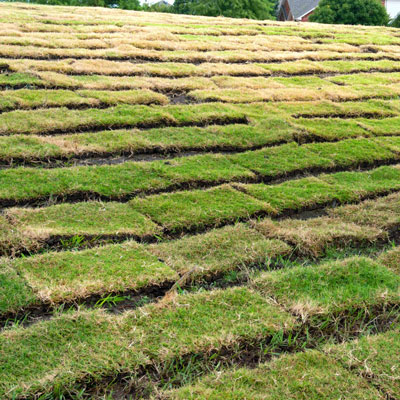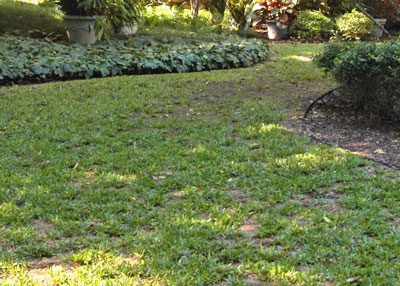Success With New Sod
I see people making some very serious mistakes when they’re planting new sod in their lawns. Since we’re at the very beginning of the lawn-starting season, I thought this might be a good time to list them.

If you’re buying very much sod, have it delivered. It is very heavy.
Do…
• Try to have your grass planted by mid-May. Temperatures will still be comparatively cool, yet it will still be moist enough to avoid having to water twice daily like you would in the summer.
• Prepare the soil carefully prior to planting. If you’re “solid-sodding,” that means rototilling (rear-tine tiller) and raking to a smooth grade. (Wait until the soil dries a bit before you do this.) You do not need to add soil amendments.
• Even before that, though, kill all the weeds and existing vegetation if you’re planting sod wall-to-wall in your landscape. Apply a glyphosate-only herbicide (no other active ingredients).
• Know ahead of time what type of sod is best. I’ll leave that for another discussion, but in simple terms, St. Augustine for part shade or full sun; bermudagrass for full sun. Zoysias fall in-between. There is no grass that will tolerate full shade.
• Buy from the best sod yard available. Your local independent retail garden center owner or manager will know who they are in your area.
• Buy fresh sod. Hopefully it will be Texas-grown, dug late in the afternoon and shipped overnight. Arrange to pick it up or have it delivered early in the morning. (Sod is very heavy if you’re bringing your own truck.)

Fresh sod will be bright green, and its soil will be moist. Avoid browned, dry sod.
• Have a team of four or five workers (great family project). Carefully lay the sod onto the tilled soil. It helps if you walk on pieces of plywood so you won’t leave footprints.
• Snug the sod up piece against piece. Cut small pieces to fit into voids that will always show up.
• Water each area of the yard as soon as you have the sod planted. Fill any conspicuous cracks between pieces, although narrow spaces will fill in very quickly.
• If the lawn looks lumpy after you have planted the sod, consider rolling it one time with a half-filled lawn roller.
• For the first two weeks, water each day (unless it rains) for about 5 minutes per area. Then gradually wean the grass to longer intervals between waterings.
• Mow at the recommended height as soon as the grass grows slightly beyond it. Keep the grass at that height. Low mowing encourages dense, spreading growth.
• Fertilize the new grass after the second mowing using an all-nitrogen food with half or more of that nitrogen in slow-release form. That first feeding should be at half the recommended rate. Then, one month later, fertilize at the recommended rate.
Don’t…
• Attempt to start new sod without first rototilling the ground and raking it smooth. Some people simply spread an inch of sand on top of the old grass and weeds, then lay out their sod. That’s a lazy shortcut that will doom you to failure – or at least to less-than-stellar results. You only get one chance to do the job right.

These people planted bermuda sod on top of established grass and weeds. They also made no attempt to fill in the cracks between pieces. It is still bumpy today.
• Accept sod only if it is free of nutsege (nutgrass). If you can see nutsedge in the thin layer of soil, turn it down. The sod-cutting machines will slice the pea-sized “nutlets” cleanly in half. If nutsedge is present, you’ll be able to see those little pieces.
• Don’t use weedkillers, including pre-emergent herbicides until the new grass has been through its first winter.
• Critical information! Do not plant sod in a really shady location, especially if other grass has died before it. If the trunk of a tree is the “epicenter” of the loss of grass, shade is the issue and it’s time to turn to a shade-tolerant groundcover. I’ll cover that another time here, but I just wanted to pitch out that challenge before you spend a lot of money.

Even St. Augustine will fail to grow when an area receives fewer than 5 or 6 hours of direct sunlight daily. At this point, it’s time to consider a groundcover.
